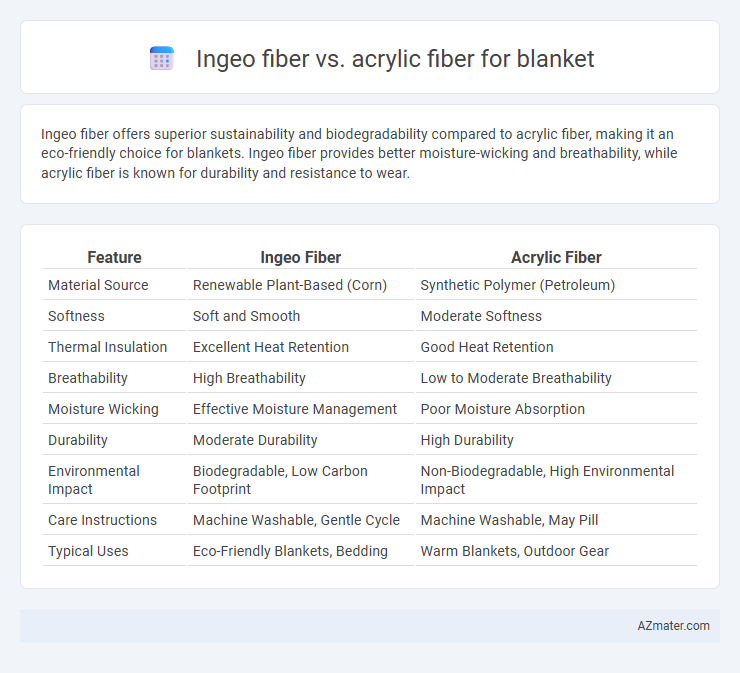Ingeo fiber offers superior sustainability and biodegradability compared to acrylic fiber, making it an eco-friendly choice for blankets. Ingeo fiber provides better moisture-wicking and breathability, while acrylic fiber is known for durability and resistance to wear.
Table of Comparison
| Feature | Ingeo Fiber | Acrylic Fiber |
|---|---|---|
| Material Source | Renewable Plant-Based (Corn) | Synthetic Polymer (Petroleum) |
| Softness | Soft and Smooth | Moderate Softness |
| Thermal Insulation | Excellent Heat Retention | Good Heat Retention |
| Breathability | High Breathability | Low to Moderate Breathability |
| Moisture Wicking | Effective Moisture Management | Poor Moisture Absorption |
| Durability | Moderate Durability | High Durability |
| Environmental Impact | Biodegradable, Low Carbon Footprint | Non-Biodegradable, High Environmental Impact |
| Care Instructions | Machine Washable, Gentle Cycle | Machine Washable, May Pill |
| Typical Uses | Eco-Friendly Blankets, Bedding | Warm Blankets, Outdoor Gear |
Introduction to Ingeo Fiber and Acrylic Fiber
Ingeo fiber, derived from renewable plant-based resources like corn, offers an eco-friendly alternative for blanket manufacturing with natural biodegradability and moisture-wicking properties. Acrylic fiber, a synthetic polymer made from polyacrylonitrile, is known for its lightweight warmth, softness, and durability but relies on petroleum-based raw materials and is less sustainable. Comparing these materials highlights Ingeo fiber's environmental benefits and breathability versus acrylic's affordability and resilience in blanket applications.
Composition and Source of Ingeo and Acrylic Fibers
Ingeo fiber is a biopolymer made from 100% renewable plant-based sources, specifically fermented corn sugars, offering a sustainable alternative to conventional fibers. Acrylic fiber is a synthetic polymer derived from polyacrylonitrile, produced through petrochemical processes using non-renewable fossil fuels. The natural origin and compostability of Ingeo fiber contrast with the petroleum-based, non-biodegradable composition of acrylic fibers commonly used in blankets.
Environmental Impact: Biodegradability and Sustainability
Ingeo fiber, derived from renewable plant-based resources like corn, offers superior biodegradability compared to petroleum-based acrylic fiber, which can persist in the environment for hundreds of years. The production of Ingeo fiber consumes less energy and generates fewer greenhouse gas emissions, enhancing its overall sustainability profile. Choosing blankets made from Ingeo fiber significantly reduces ecological footprint by supporting renewable materials and promoting faster decomposition in natural settings.
Warmth and Insulation Properties Comparison
Ingeo fiber, derived from renewable plant-based materials, offers superior moisture-wicking and breathable insulation properties compared to acrylic fiber, enhancing warmth retention in blankets without overheating. Acrylic fiber, a synthetic polymer, provides durable, lightweight warmth but lacks the natural temperature-regulating benefits found in Ingeo fiber. Blankets made with Ingeo fiber deliver eco-friendly thermal comfort with better insulation efficiency, making them ideal for maintaining consistent warmth in varying climates.
Softness and Comfort: User Experience
Ingeo fiber offers superior softness and breathability compared to acrylic fiber, providing a natural, smooth texture that enhances comfort in blankets. Users frequently report that blankets made with Ingeo fiber feel lighter and more temperature-regulating, reducing sweat and irritation during use. Acrylic fiber, while durable, tends to be less breathable and can cause discomfort or static, making it less ideal for sensitive skin or extended wear.
Durability and Longevity in Daily Use
Ingeo fiber, derived from renewable plant-based materials, offers superior durability with enhanced resistance to stretching and abrasion compared to traditional acrylic fibers commonly used in blankets. Acrylic fibers tend to pill and degrade faster under frequent washing and daily wear, while Ingeo fiber maintains structural integrity and softness for an extended period. This makes Ingeo blankets a more sustainable and long-lasting choice for everyday use.
Moisture Wicking and Breathability
Ingeo fiber, derived from renewable plant-based materials, offers superior moisture-wicking properties compared to acrylic fiber by efficiently drawing sweat away from the skin to keep the blanket dry and comfortable. Its natural breathability allows for better air circulation, enhancing temperature regulation during use. Acrylic fiber, while durable, tends to trap heat and moisture, making it less effective for breathable, moisture-managing blankets.
Allergenicity and Skin Sensitivity Considerations
Ingeo fiber, derived from renewable plant sources, offers hypoallergenic properties that reduce the risk of skin irritations and allergic reactions, making it suitable for sensitive skin compared to traditional acrylic fiber. Acrylic fiber is a synthetic material that can sometimes trap heat and moisture, potentially causing discomfort and exacerbating skin sensitivities or allergies. Blankets made with Ingeo fiber provide enhanced breathability and moisture-wicking capabilities, promoting a cooler and more comfortable experience for individuals with allergy concerns.
Cost Analysis: Affordability and Value
Ingeo fiber offers a sustainable and eco-friendly alternative to acrylic fiber with a slightly higher cost due to its renewable source and manufacturing process. Acrylic fiber is generally more affordable upfront, making it a budget-friendly choice for blankets, but it may lack the environmental benefits and biodegradability of Ingeo fiber. Evaluating the total value, Ingeo fiber blankets provide long-term benefits through durability and reduced environmental impact, potentially justifying the initial price difference for eco-conscious consumers.
Final Verdict: Choosing the Right Fiber for Your Blanket
Ingeo fiber, derived from renewable plant sources, offers superior moisture-wicking, biodegradability, and eco-friendliness compared to traditional acrylic fiber known for durability and affordability. Acrylic fiber excels in wrinkle resistance and color retention, making it suitable for budget-conscious consumers seeking easy-care blankets. For a sustainable, breathable, and softer blanket, Ingeo is preferable, whereas acrylic suits users prioritizing long-lasting vibrant blankets at a lower cost.

Infographic: Ingeo fiber vs Acrylic fiber for Blanket
 azmater.com
azmater.com